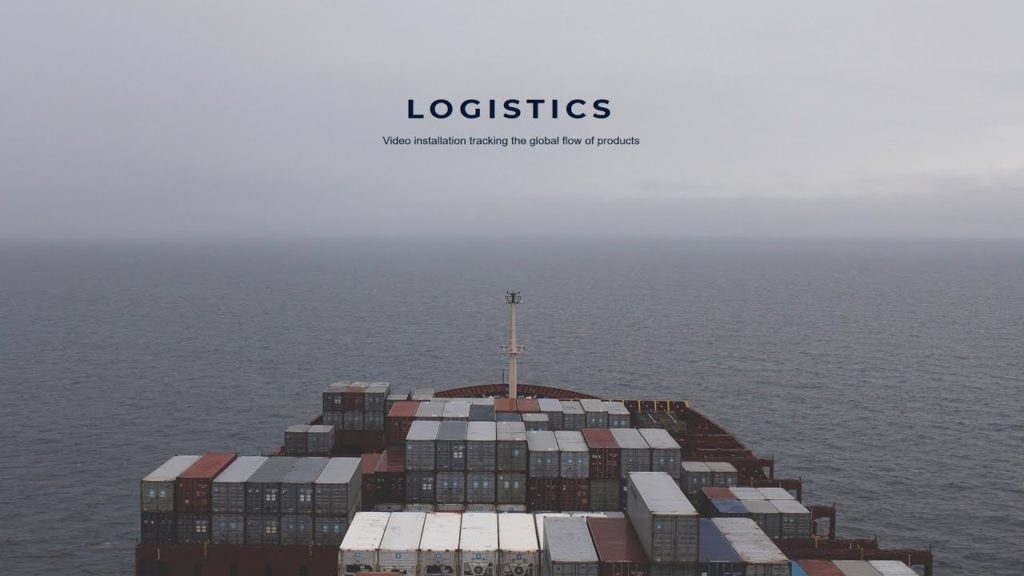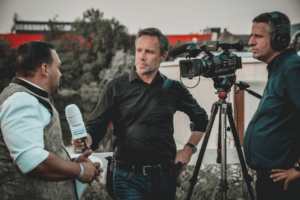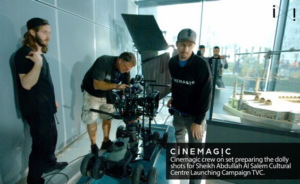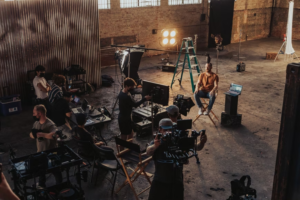Maybe you’ve recently watched the most recent installment of The Avengers. Or perhaps you’re wondering why there’s a two-year gap between every Star Wars picture. It’s not uncommon to find yourself asking, “how long does it take to make a movie?” But, of course, various factors go into making a film, and if you’re not in the industry, the answer may not be obvious.

To truly understand how extensive the filmmaking process is, we’ll take a deeper look at all of the steps involved. To throw a brief answer (in case you’re in a hurry), the average length of a feature film is around 120 minutes. This figure is typically taken for an introductory film, and it excludes time spent on special effects or the production of music. However, it takes a lot more to make a movie than simply what we see on the screen. Before it is ready for public release, the film must go through numerous stages. Each of these steps necessitates time, some more than others.
Timeframe
To honestly answer how long it takes to make a movie, we must first evaluate the timeframe involved and which steps must be taken.
In general, the timeline of filmmaking can be divided into three major sections:
- Pre-production (3-7 months)
- Production- Principal Photography (3 months)
- Post-production (7 months-1 per years)
However, other processes must be completed before even beginning pre-production.
How long does it take to make different types of movies?
The art of filmmaking is not a one-person show. Instead, an entire crew works day in and day out for the project’s success. Various script features decide the duration of the film shoot and its release. The time taken for the movie release right from the moment the script is conceived to the post-production stage depends on the genre:
Indie
Independent movies are filmed on minimum budgets. Hence, the production time, the most expensive part of filmmaking, is shorter. Cinematographer Hiroshi Hara says, “It takes around 3-6 months for the pre-production phase, 1-2 months for the principal photography stage, and finally 6 months- 1 year for the post-production.”
Romance
One of the most enjoyed genres of all time, it takes less time to film such movies. It takes just a few weeks to produce and moves quickly through editing. In addition, romances have few action sequences, special effects, and comparatively fewer actors or settings. Thus, a movie shot in summer can be released on Netflix by Christmas.
Drama
Budgets and film scope decide the duration of dramas. For example, a plot revolving around a couple in Manhattan costs less than a periodical drama with extravagant costumes and settings. On the other hand, a battle epic or fantasy drama takes a lot of time, accessories, coordination of the team, and other extra accessories to shoot, adding to the production time and movie release.
Superhero or sci-fi action
Be prepared for time travel down the lane or into the future with exciting plots and enthralling settings. Filled with action sequences, VFX, DC,
and sound effects, sci-fi movies need a lot of time in post-production. Still, with the resources of a major studio, these large-budget films come together fast. Avengers: Endgame took five months in production and screened in theaters 15 months later.
Animation
The number of animators on the team decides the duration of animated movies. For example, a feature film by Pixar or Disney takes five years to make, with more than 100 animators working together for several months.
Finance, Story, and Script
To begin, you’ll need a story, a script, and funding. If you’ve ever pondered on what a movie producer does, you should know that they are involved from the beginning to the end of the process, which is one of the most critical aspects of their job.

Producers start by identifying potential material for development and then hire people to work on it to either polish a current script or commission a screenwriter to create a new script for the project. After that, the producer takes the finalized script and leads pitches to seek funding for the film.
Depending on the project, this procedure could take years or months. For instance, while Sylvester Stallone only needed three days to create the script for the first Rocky film, Kill Bill‘s concept and the story took Quentin Tarantino 5 years to develop.
The Announcement
The date of the announcement is regarded as the date when the film is officially announced. It could be when the industry reveals that the script has been pitched or when the media is formally informed that the movie will be filmed.
Why do studios reveal movies early?

Movies are generally announced years in advance by studios. One of the primary reasons is to outperform the competition. They wish to share their thoughts with the rest of the crew. It aids them in securing a favorable release date on the calendar. Also, they have to be sure that there is no overlap with a similar topic or subject. Movies based on folklore, fairy tales, or actual events are always made official in advance. Because these stories are in the public domain, they want everyone to know what is already in the works.
How Marvel Actually Makes Movies Years Before Filming
Early announcements often assist marketing, and social media teams create a “buzz” about the film. They build fan bases and market the movie. Some photos from the studios on Instagram or teasers on YouTube may get the crowd going. However, if the film fails to live up to expectations, these strategies can backfire.
Pre-production Stage
Pre-production is used to describe all preparations undertaken after a project has been approved but before shooting begins. There is a vast range of conceivable pre-production periods, similar to production, but to a greater extent.

Pre-production is a crucial stage in the production process that may make or break a project. First, the director begins hiring heads of departments and usually is aware of the project’s start date. Next, they’ll have to think about casting and who will play which roles. In some instances, they’ll even decide the intended release date for this time range and efficiently coordinate marketing approaches.
Here’s a rundown of everything that happens during the pre-production phase:
- The script has been developed, finished, and funded.
- The production business has been formed.
- A budget and timetable have been established.
- Department heads are hired after being scouted. The leaders of departments will next begin their creative plan and schedule.
- Leasing, permissions, and locations have all been arranged.
- Department heads hire their staff, and performers audition and are cast.
- Rehearsals have started, and production has begun.
Pre-Production Planning For Video
Sure. A lot. It should be evident that all of this needs to be done, but the average moviegoer does not consider it.
As we previously explained, this process usually takes 8-12 weeks generally, and as we have seen, it can take much, much longer.
What is Development Hell?
Pre-production might take years, if not decades. As a result, many films — typically personal projects or reboots of significant franchises – enter a limbo known as development hell. These projects are essentially stuck in pre-production for years due to one of the following factors:
- Edits, recasting, and crew alterations are typically the result of executive decisions made after the copyrights to a screenplay have been acquired.
- Problems with rights agreements and contract disputes.
- Strikes among writers, the crew on board, or cast members.
- Funding issues. Either being unable to obtain finance in the first place, running out of funds, having funding withdrawn, or being shifted between studios.
- Death of a cast member or a significant member of the production team.
Development hell isn’t limited to pre-production and affects films at every production stage. However, it is far more prevalent in cinema featuring prominent directors, studios, and series.
Top 10 Movies That Were Stuck In Development Hell
Now that we’ve discussed how much time pre-production takes, let’s look at what happens once the film is completed.
Post Production
Post Production refers to all of the activity after the shooting is completed. This is a lot more comprehensive than you might think. It entails editing and color correction, original soundtrack writing and mixing, foley, ADR, and VFX application.

For those who don’t know:
Foley
Foley is the recreation of typical sound effects such as footsteps, creaking doors, and so on to improve audio quality. Because everything sounds realistic in the picture, good foley work goes unnoticed by the audience.
ADR (Automated Dialogue Replacement)
The majority of people in the industry have no idea what the acronym stands for. They only understand that it relates to re-recording the dialogue to dubbed over footage. This is done to correct audio errors or, in rare cases, to change the conversation in the scene.
VFX (Visual Effects)
The process of producing visuals outside of a live-action shot, generally using computer animation (Computer Generated Imagery). It is often confused with SFX (special effects), which refers to the live-action impacts performed on the set.
Stages of Post-Production for Filmmaking in Cinema
VFX can be the highest time-consuming of all procedures. When you think of digital effects, you generally imagine fire-breathing dragons or vast space empires. However, the spectrum of visual effects is far broader. For example, visual effects could include things you never see, such as ambient snow or a breeze.
So, how long does it take between production and release?
Many studios declare the completion date of their movie. And we know that the average turnaround time for post-production is 10-20 weeks. So, why is there such a large gap between the completion of production and its theatrical release?
Creating trailers and advertising campaigns must be done to gather an audience for the film. As previously said, the film must be presented with focus groups, which may need re-edits or re-shoots.
And, of course, producers must allow for a considerable margin of error. As previously said, there are an almost unlimited number of things that can go wrong during the filming process. Theatrical premieres are scheduled months in advance and are highly expensive to reschedule. In addition, dates are frequently chosen based on a combination of audience data and rival releases, so rescheduling is often not an option.
The longest film ever made
The average length of a film is between 70 and 90 minutes. Logistics, a Swedish conceptual movie, is the longest film ever filmed. This film lasts 857 hours, equating to 4 weeks and 17 hours. This is not a dialogue-driven film with actors. Instead, Erika Magnusson and Daniel Andersson were curious about the origins of modern technological gadgets.

As a result, they decided to shoot a film in real-time, in an inverse chronological sequence. The film follows the pedometer from its retail location in Stockholm to its manufacturing location in Bao’an. Because it is simply impossible to watch a video for more than 35 days in a row, the film is divided into 2-minute pieces, one for each day of the pedometer’s trip from the factory to its new owner.
Amra Ekta Cinema Banabo (The Innocence) is another longest cinematic film. After the Bangladesh independence struggle, a film produced in Bangladesh discusses revolt, politics, ambitions, and love. The film lasts 21 hours.
The 3 Stages of the Video Production Process
Everything It Takes to Make A Marvel Movie
In conclusion
Movies are made up of probably hundreds of moving pieces. They take months, if not years, to design and refine, and the “filming” of the movie is often the quickest and easiest phase. To understand how long it will take to make a movie, a director must have a solid understanding of the task. A movie might take a few months to a decade because of the many possibilities that can go wrong.
Hopefully, this post has deepened your appreciation for the films you already adore and taught you more about the filming process.













